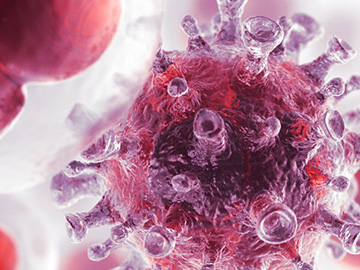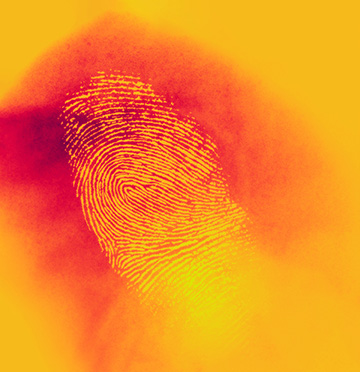![]()
Ioachim Pupeza (left) and Marinus Huber (right) were co-first authors on a new study that could significantly improve the use of mid-infrared lasers for probing biological samples. [Image: Thorsten Naeser/MPQ]
The advent of increasingly powerful, sophisticated mid-infrared (MIR) light sources, such as quantum cascade lasers, has stoked interest in “molecular fingerprinting.” In principle, spectroscopy using such lasers allows scientists to probe individual bond vibrations in biological samples, and thereby create a unique, fingerprint-like signature of entire molecular assemblages in complex biological systems. But in such measurements, the faint signals from sparse—but potentially important—molecular markers can get lost in the intensity noise from the light used to excite the molecules.
A research team led by scientists at the Ludwig Maximilians University München (LMU) and the Max Planck Institute of Quantum Optics (MPQ), Germany, has put a potential solution to that quandary on the table (Nature, doi: 10.1038/s41586-019-1850-7). The team’s solution uses a combination of millions of ultrashort, broadband pulses to probe the sample, and electro-optic sampling to pick apart the resulting, integrated molecular signal and isolate it from intensity noise.
Based on tests with human blood samples and other biomaterials, the LMU–MPQ team reports that the system can, in a single experiment, probe complex molecular assemblages down to concentrations of hundreds of nanograms per milliliter—across a dynamic range of concentrations (from the most abundant to sparsest molecular species) exceeding 105. That opens up the prospect of taking a complete molecular profile of a given clinical sample in one measurement—with an acquisition time on the order of minutes.
Early leverage on cancer
Many molecules have chemical bonds that vibrate strongly in the MIR frequency region. Molecular fingerprinting works by exciting such molecules with an MIR light source, and using the spectra of the re-emitted light to uniquely identify specific molecules from those bond vibrations (see “Mid-IR Spectroscopic Sensing,” OPN, June 2019).
Among many applications in environmental monitoring, industry and biomedicine, there’s particular interest in molecular fingerprinting to provide early indications of cancer. That’s because precancerous or malignant cells tend to churn out specific molecular markers that can serve as among the first signs of tumors in the body.

[Image: Getty Images]
The problem is that these marker molecules for incipient cancer occur at extremely low concentrations. The signal from a mid-IR spectroscopic experiment, however, is a superposition of the spectral responses of all molecules in the sample—what the authors of the new study refer to as the global molecular fingerprint (GMF).
In principle, the signals from the sparser molecular markers can be made detectable by boosting the power of the excitation laser. But in practice, most spectroscopy setups capture and analyze light fields integrated across a time window. In such setups, the noise from the excitation laser, transmitted through the sample, hits the detector at the same time as the GMF, swamping the signal from less abundant molecular markers.
Time-gated detection
To get to an approach that could capture complete molecular assemblages, across a wide dynamic range, the LMU–MPQ-led team, headed up by OSA Fellow Ferenc Krausz, looked at a fundamentally different approach. Rather than relying on a time-integrated (that is, frequency-resolved) signal, their setup, which they refer to as field-resolved spectroscopy (FRS), employs a time-gated approach.
In that approach, a series of ultrashort, few-cycle broadband pulses is used to first excite the sample. Then the sample response—the GMF, re-emitted from the molecular bonds at different frequencies—is probed at even shorter intervals, through the technique of electro-optical sampling. Chopping up the sample response in this way, across a train of multiple pulses, isolates ultrabrief fractions of the GMF from longer-wavelength background noise, allowing the signal of even low-concentration GMF contributors to shine through.
Hard-working NIR beam
The team’s experimental setup begins not with an MIR beam, but with near-infrared (NIR) light—a train of 28 million pulses per second, from a Yb-YAG disk laser source that passes through three compression stages, eventually reaching an ultrashort pulse duration of 16 fs. The NIR pulse train is then focused on a LiGaS2 crystal, where nonlinear interactions convert part of the incident NIR radiation into a phase-matched MIR pulse train.
Next, the incident NIR and generated MIR pulse trains are separated at a dichroic mirror to follow different paths. The MIR train is transmitted through a liquid cuvette containing an aqueous biological sample, where it stimulates bond vibrations re-emitted as the GMF in the wake of the ultrashort excitation pulse. The NIR pulse train, meanwhile, passes through a mechanical delay stage that allows the pulse train’s time delay relative to the MIR pulses to be adjusted.

The LMU–MPQ system promises a faster way to obtain complete “fingerprints” of molecular samples. [Image: Getty Images]
At the end of the chain, the beams are recombined in a nonlinear crystal, with the time delay of the shorter-wavelength NIR pulses varied to sample different, ultrashort parts of the longer-wavelength MIR signal. A portion of the NIR beam is also used as a local oscillator, allowing the signal to be picked up as beats via heterodyne detection. The ultrashort samples, isolated from infrared background noise, are then recombined into the full molecular fingerprint, where molecular markers even at relatively low concentrations can be identified.
Overcoming water absorption
In addition to other potential advantages, the researchers point out that the system’s high sensitivity can overcome another long-standing disadvantage of MIR spectroscopy: the strong absorption of infrared radiation in liquid water. In the past, that absorption has limited the technique’s use to artificially dried samples less than 10 μm thick.
The new FRS system appears to offer a path around those limitations. In their initial proof of concept, the researchers used the system to test for molecular fingerprints in human blood serum and organic molecules in aqueous solution. They found that they could pick up concentration changes of a few hundred nanograms per milliliter in such samples after less than a minute’s data acquisition time. They also used the system to probe some optically opaque materials, such as an intact leaf specimen from a goat willow tree (Salix caprea), and were able to pull out the fingerprints of carbohydrates in the cell walls even of these strongly attenuating specimens.
“This ability to accurately measure variations in the molecular composition of body fluids,” one of the study’s authors, Mihaela Zigman, said in a press release accompanying the work, “opens up new possibilities in biology and medicine, and in the future the technique could find application in the early detection of disorders.”
In addition to LMU and MPQ, the research team included scientists from King Saud University, Saudi Arabia, and the Center for Molecular Fingerprinting, Hungary.
